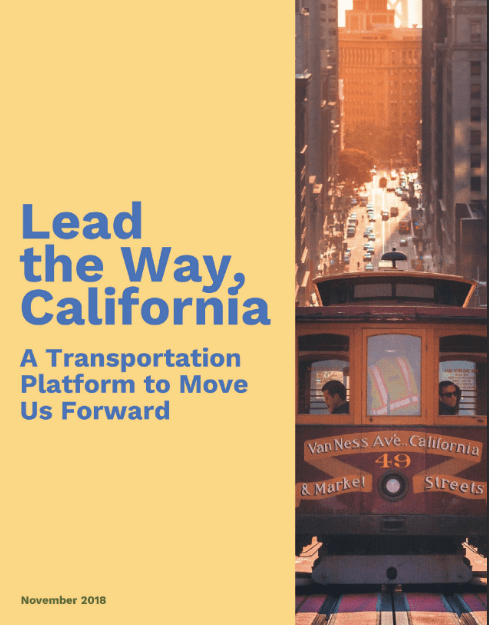The next governor of California will enter office with one big problem—transportation funding—already solved, at least for the moment. The passage of S.B. 1 and the defeat of Prop 6 guarantee that for the next few years the state will have enough money to fix some of its transportation problems. But it would be a mistake to let the remaining issues take a back seat to other pressing concerns, including housing and environmental issues, because they all are so inextricably linked.
Newsom has been pretty quiet about his priorities, although a pre-election survey of gubernatorial candidates by TransForm and a group of sustainable transportation advocacy organizations gives a hint on his thinking. His ideas align with those of many advocates, including investing in transit and active transportation, prioritizing the needs of low-income communities, and getting autonomous vehicles to be shared, electric, and accessible. Among his responses to the survey was a promise to put the same energy towards building out the state rail system that Governor Brown has put into supporting high-speed rail. (Newsom's full responses to the survey can be found here.)
This week, a coalition of almost fifty groups, among them Climate Resolve, ClimatePlan, PolicyLink, California Bicycle Coalition, California Walks, the Planning and Conservation League, the Coalition for Clean Air, and TransForm, suggested a comprehensive transportation platform for the new governor to consider. As the press release puts it:
The platform will enable the new Administration to provide every Californian access to convenient, dignified, and low-cost transportation options. The platform also addresses the related goals of building affordable homes and preserving land. It builds on California’s global leadership in lowering greenhouse gas emissions, transitioning to clean energy, and combating climate change.
The platform is based in a vision for California that elevates active and environmentally friendly modes and sees streets as shared public spaces, not just traffic sewers, in places where everyone has a home and can access what they need.
It lays out five actions for the new Governor, with detailed discussions about how they can be achieved.
For example, the first action is to prioritize transportation “that moves California forward” on state goals. This would means bringing transportation funding policy in line with state goals for climate, equity, and public health, and evaluating projects against their effects on things like public health and community impact. It would necessitate a thorough examination of how transportation funding is currently spent, a subject that can be confusing even to the people most knowledgeable about it.
The platform includes recommendations from the recent Air Resources Board report on the lack of progress towards climate goals resulting from regional transportation planning processes that were shifted a decade ago. One of those recommendations was to create a statewide action plan to figure out what is stopping that progress and what needs to change to fix the problem.
In addition to requiring better transparency on funding decisions and holding regions accountable for their progress, the platform recommends keeping up pressure to finish the work on CEQA being conducted by the Office of Planning and Research. For the past five years OPR has been working to remove traffic congestion as an environmental impact that must be measured and mitigated for in development projects, a practice that has led to many unintended consequences, chief among them wider, faster streets that discourage walking, biking, and transit use.
The bold platform also recommends updating the California Transportation Commission's mission and structure so that body's transportation funding decisions align with state goals on the environment and equity. It recommends that the new governor appoint commissioners who understand transportation equity and justice, who represent more than just a narrow band of developers and labor organizations, and who understand the connections between transportation funding, public health, and the climate.
There are many more parts to these suggestions, and a lot for the new governor to think about, including recommendations on improving public engagement, championing housing justice, and keeping up the fight to preserve California's Clean Vehicle Standards. He wouldn't be doing this alone, and the nearly fifty signers of the platform would be strong vocal supporters of policies that align with these ideas.
Also, by adopting this platform Newsom would demonstrate clear leadership for all state agencies to work towards a climate-friendly, fair, sustainable state.
The document makes clear that it isn't necessary to start from scratch. Much work towards these goals has already been done. For example, programs that invest cap-and-trade funds, such as the Affordable Housing and Sustainable Communities program, have brought together different sectors to work on areas of mutual concern. That could be a model for aligning various state agencies to move more efficiently towards state goals, rather than having various sectors work at cross purposes to each other.
A good place for the new governor to start is with the California Transportation Commission. Three commissioners are up for reappointment in February. During his tenure, Governor Brown did very little to change the makeup of the commission, in most cases simply reappointing the commissioners. He also resisted discussing his appointment process. The result is that some of the current commissioners have served on the board for decades. Newsom would be well served to take a closer look at who the commissioners are, why they want to be on the board, and whether they are the best choices for those positions.
At the very least, he should be willing to consider other candidates, and to be transparent about his appointment process. Brown's lackluster appointing gave the impression that he didn't much care, or believed that the commission wasn't very important. But that is a mistake; the California Transportation Commission wields too much power for the new governor to ignore it.







